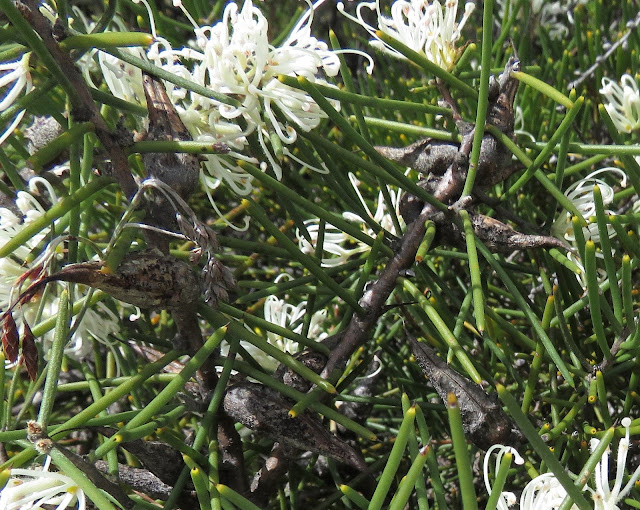Sharp in fruit and leaf
While we are in the Bay of Fires, as we were a fortnight ago with the (hairless) Hairy Boronia, here is the equally common native shrub, Hakea teretifolia.
I wondered at first whether this might be the Tasmanian endemic species, Hakea megadinia. After all, the glistening yellow-green nectary glands stand out in these photographs, and 'megadinia' means large gland.
Looking more closely into the bush I spied the distinctive dagger-shaped fruits that characterise Hakea teretifolia. The stiffness of the needles is also more like that species.
The Dagger Hakea, as it is called, is worth a post, even though widespread in the heathlands of New South Wales, Victoria and Tasmania. It's not commonly grown, presumably due to its unruly appearance overall, as well as the spine-tipped leaves and maybe the aggressive looking fruits when they accumulate on mass.
In flower, it's rather pretty, particularly in the bushland flanking Swimcart Beach. And the tangle of branches and sturdy needles provides excellent habitat for small birds.
The Dagger Hakea is, like many hakeas, usually described as an 'obligate seeder'. That is, seed is stored inside a woody fruit so that when a fire burns through the heathland that seed survives, to fall to the ground and (aided as it happens by chemicals in the smoke) germinates readily to replace the parent tree. 'Resprouters', such as many eucalypts and some banksias, are not killed by the fire and will resprout as well as sometimes sow seed.
It's surprising perhaps that the succulent leaves of this species are flammable, but all up there is a lot of wood in the stems and fruit so burn it does. Given the fruits of the Dagger Hakea are thinner-walled and smaller than some in the genus, and there is some mortality of seed in very hot fires, it may be that this leaf succulence and the cylindrical leaves may be important in dampening the intensity of the fire a little.
Also, there are some populations (part of subspecies hirsuta - a reference to different kind of hairs on the flowers) in Victoria that have lignotubers under the ground, so can resprout after fire.
If you are brave enough to grow this species in your garden - putting up with the (literal) barbs and the potential flammability if you live in a fire-prone area - it will not only attract local wildlife but can be a useful deterrent to intruders.





Comments